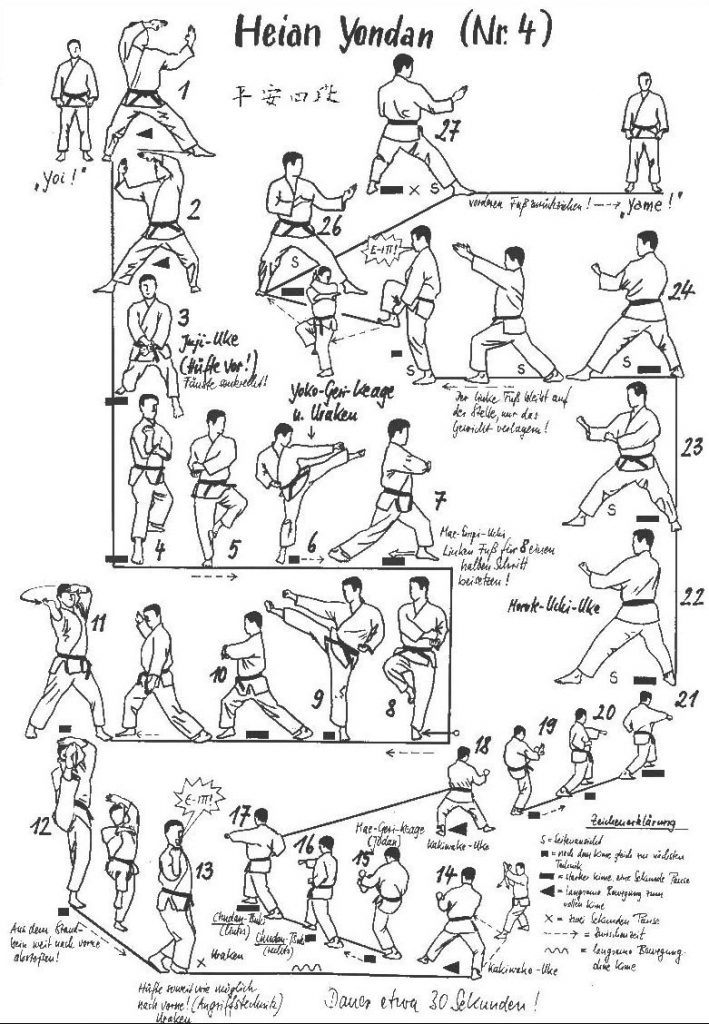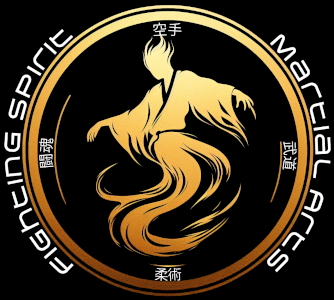Welcome back to our exploration of the Heian series of Kata in the Chito–Ryu curriculum. As a reminder, the Heian series consists of five fundamental kata that serve as the foundation for Chito-Ryu karate practitioners. Each kata in the series builds upon the skills acquired in the previous ones, progressively challenging students to develop their techniques, strength, and understanding of the art. Today, we will delve into the fourth kata in this series, Heian Yondan, shedding light on its unique features, importance, and key techniques.

Heian Yondan holds a significant position as the fourth kata in the series, acting as a bridge between the intermediate techniques found in Heian Sandan and the more advanced techniques presented in Heian Godan. As students progress through the Heian series, the complexity of the movements and combinations steadily increases, and Heian Yondan is no exception.
Mastering Heian Yondan is essential for Chito-Ryu karate practitioners as it introduces and refines a variety of essential techniques and principles. This kata challenges students to develop greater balance, coordination, and fluidity in their movements, while also emphasizing proper stances, transitions, and body alignment. The practice of Heian Yondan not only enriches the students’ technical repertoire but also cultivates the mental discipline and focus required for more advanced levels of training.
In this blog post, our primary goals are to provide a comprehensive overview of Heian Yondan, highlight its key techniques, and offer practical tips for practicing the kata effectively. By understanding the structure and purpose of Heian Yondan, practitioners can better appreciate its significance within the Chito-Ryu curriculum and refine their own performance of the kata.

To achieve these goals, we will begin by exploring the background and significance of Heian Yondan, delving into its history and role in the progression of the Heian series. Next, we will provide an overview of the kata, outlining its unique features and flow, as well as discussing the key movements and stances it encompasses. We will then focus on the key techniques found in Heian Yondan, examining their purpose and application in detail. Finally, we will share practical tips for practicing Heian Yondan, ensuring that students can effectively hone their skills and deepen their understanding of this essential kata.
By the end of this blog post, we hope that you will have gained valuable insights into Heian Yondan, allowing you to further enhance your practice and embrace the challenges presented by this pivotal kata in the Heian series.
Background and Significance of Heian Yondan
The history and origins of Heian Yondan can be traced back to the ancient martial arts of Okinawa, Japan. The Heian series itself was created by Master Anko Itosu in the early 20th century, who aimed to simplify the older and more complex katas known as the Shorin and Shorei katas, making them more accessible to a broader range of students. Heian Yondan, like the other kata in the series, derives its name from the phrase “Heian,” which translates to “peaceful mind” or “peace and tranquillity.” This concept reflects the core philosophy of Chito-Ryu karate, emphasizing the importance of mental composure and inner peace in martial arts practice.

Heian Yondan, as the fourth kata in the series, builds upon the foundation laid by the previous three katas – Heian Shodan, Heian Nidan, and Heian Sandan. The techniques and principles introduced in these earlier katas are further refined and expanded upon in Heian Yondan, ensuring a smooth progression for practitioners as they advance through the Heian series. The inclusion of new techniques, such as Kake Uke (Hook Block), helps students broaden their technical repertoire and deepen their understanding of Chito-Ryu karate.
In essence, Heian Yondan is a vital component of the Chito-Ryu curriculum that has evolved over time to serve as an effective training tool for students of varying skill levels. As practitioners continue their journey through the Heian series, they develop a strong foundation in Chito-Ryu karate, both in terms of physical techniques and the underlying philosophy, which ultimately prepares them for more advanced levels of training.
As we explore the role of Heian Yondan in the progression of the Heian series, it’s essential to understand how it fits within the larger context of Chito-Ryu karate training. Heian Yondan, being the fourth kata in the series, plays a pivotal role in advancing students’ skills and understanding of the art.
In the Heian series, each kata serves as a stepping stone, gradually introducing new techniques and principles while reinforcing those learned in previous katas. As students progress from Heian Shodan to Heian Nidan and then Heian Sandan, they develop a solid foundation of basic techniques and stances. Heian Yondan builds upon this foundation by introducing more intricate combinations, advanced techniques, and an increased emphasis on fluidity and precision.
The role of Heian Yondan is twofold: first, it consolidates and refines the skills acquired in the earlier katas, ensuring students have a firm grasp of the fundamentals. Second, it prepares students for the more advanced techniques and concepts they will encounter in Heian Godan, the final kata in the series.
By practicing Heian Yondan, students develop enhanced balance, coordination, and fluidity in their movements. Additionally, the kata emphasizes the importance of proper stances, smooth transitions, and correct body alignment. This focus on precision and technique not only enriches the students’ technical repertoire but also cultivates the mental discipline and focus necessary for mastering more advanced katas.

Heian Yondan, therefore, serves a crucial role in the progression of the Heian series by bridging the gap between intermediate and advanced techniques, while simultaneously reinforcing fundamental skills. This well-structured progression ensures that practitioners are well-equipped to handle the increasing complexity and challenges presented by the more advanced katas in the Chito-Ryu curriculum.
The purpose of practicing Heian Yondan in Chito-Ryu karate lies in its ability to further develop and refine the skills and understanding of practitioners as they progress through the Heian series. By engaging with Heian Yondan, students can not only strengthen their grasp of fundamental techniques but also prepare themselves for more advanced challenges that they will encounter in their karate journey.
Heian Yondan serves as a valuable learning tool that imparts essential techniques and principles in a structured and systematic manner. It introduces students to a variety of advanced techniques and combinations, allowing them to build a versatile and comprehensive technical repertoire. These new techniques help students develop their coordination, balance, and fluidity, all crucial elements for success in Chito-Ryu karate.
Moreover, practicing Heian Yondan contributes to the development of mental discipline and focus. The kata’s emphasis on precision, smooth transitions, and proper body alignment encourages students to cultivate a strong sense of mindfulness and self-awareness. This mental aspect of training is equally important as the physical, and through Heian Yondan, students can better appreciate the interconnected nature of the body and mind in martial arts.
An Overview of Heian Yondan
Heian Yondan is a dynamic kata that introduces advanced techniques and combinations while reinforcing the skills learned in earlier katas. Its unique features and flow set it apart from the previous katas in the series, offering students a chance to develop greater balance, coordination, and fluidity in their movements. Key movements and stances in Heian Yondan include:
- Kake Uke (Hook Block): This technique, unique to Heian Yondan, teaches students to effectively deflect incoming attacks using a hooking motion with their arm, while simultaneously preparing for a counterattack.
- Kosa Uke (Cross Block): A signature Chito-Ryu technique, Kosa Uke is a double-handed block that requires precise timing and body alignment.
- Kokutsu Dachi (Back Stance): This defensive stance, featured prominently in Heian Yondan, emphasizes proper weight distribution and balance, providing a strong foundation for executing various techniques.
The flow of Heian Yondan is characterized by its seamless transitions between movements and stances, requiring students to maintain a high degree of balance and coordination throughout the kata. It is through the practice of this kata that students develop the ability to execute advanced techniques and combinations with precision, while also maintaining a strong foundation in the fundamentals.
The importance of balance and coordination in performing Heian Yondan cannot be overstated. As students progress through the Heian series, the complexity of the techniques and combinations increases, placing a greater emphasis on the need for a strong foundation in balance and coordination.
In Heian Yondan, students are challenged to execute advanced techniques, such as Kake Uke and Ushiro Geri, which require an elevated level of balance and coordination. Moreover, the kata demands smooth transitions between movements and stances, further emphasizing the need for students to maintain their equilibrium throughout the performance.
Karate is like boiling water. If you do not heat it constantly, it will cool.
Gichin Funakoshi
By practicing Heian Yondan, students not only develop their physical skills but also cultivate the mental discipline required to maintain balance and coordination in increasingly complex scenarios. The mastery of these aspects is crucial for success in Chito-Ryu karate and contributes to the overall development of a well-rounded martial artist.
Enhancing Performance of Heian Yondan: Practical Tips
The journey toward mastering Heian Yondan requires consistent practice, dedication, and a focus on refining one’s technique. To effectively enhance your performance of this kata, consider implementing the following tips into your training routine:
- Focus on proper stances and body alignment: As the foundation of all techniques, ensuring correct stances and body alignment is critical. Devote time to practicing each stance separately, paying close attention to foot placement, weight distribution, and posture. This attention to detail will translate to improved performance and increased stability throughout the kata.
- Practice individual techniques separately before combining them: Break down the kata into its individual components, and practice each technique separately to develop precision and fluidity. Focus on executing each movement with proper form and timing before integrating them into the full kata sequence. This approach will allow you to hone your skills and address any weaknesses before they become ingrained in your muscle memory.
- Pay attention to the flow and rhythm of the kata: Heian Yondan emphasizes smooth transitions and continuous flow throughout its sequence. To achieve this, practice the kata at a slower pace initially, focusing on seamless transitions between techniques and stances. Gradually increase the speed as you become more comfortable with the flow, always prioritizing precision and control.
- Utilize visualization techniques to enhance understanding: Mental rehearsal is a powerful tool for deepening your understanding of the kata. Visualize yourself performing Heian Yondan with perfect form and timing, mentally walking through each movement and transition. This practice will help reinforce the correct techniques and sequences in your mind, ultimately translating to improved physical performance.
- Incorporate Heian Yondan into regular practice routines: Consistent practice is key to mastering any kata, and Heian Yondan is no exception. Make a conscious effort to include Heian Yondan in your regular training sessions, even if only for a few repetitions. This consistent exposure will help solidify your understanding of the kata, as well as identify areas where you may need to devote more attention.
By incorporating these practical tips into your training regimen, you can effectively enhance your performance of Heian Yondan and continue your journey towards mastery of the Chito-Ryu karate curriculum. Remember, the path to becoming a proficient martial artist is a lifelong endeavour, and refining your skills in the Heian series is an essential step in that journey. Embrace the challenges presented by Heian Yondan, and utilize the lessons learned to propel your growth and understanding of Chito-Ryu karate.
In Conclusion
In conclusion, Heian Yondan plays a pivotal role in the Chito-Ryu karate curriculum, acting as a bridge between intermediate and advanced techniques. This fourth kata in the Heian series challenges practitioners to develop their skills in balance, coordination, and fluidity while refining the fundamentals acquired in the previous katas. Through Heian Yondan, students are introduced to advanced techniques such as Kake Uke and Ushiro Geri, as well as reinforcing essential stances like Kokutsu Dachi.
To effectively improve your performance of Heian Yondan, we encourage you to focus on proper stances and body alignment, practice individual techniques separately, pay attention to the flow and rhythm of the kata, utilize visualization techniques, and incorporate Heian Yondan into your regular practice routines. These tips will help you deepen your understanding and mastery of this crucial kata.
We hope this blog post has provided valuable insights into the importance, techniques, and practice of Heian Yondan within the Chito-Ryu karate curriculum. We encourage you to continue exploring and perfecting your Heian Yondan kata, as well as honing your skills in the entire Heian series. Remember that the pursuit of mastery in martial arts is a lifelong journey, and each step along the way contributes to your overall growth and understanding of the art.
Stay tuned for our upcoming sixth blog post, where we will delve into Heian Godan, the fifth and final kata in the Heian series. This final kata will present even more advanced techniques and concepts, challenging practitioners to further expand their technical repertoire and deepen their understanding of Chito-Ryu karate. Until then, keep training diligently and embracing the challenges presented by the Heian series.
The Kata: Heian Yondan
This kata, like most other kata you’ve learned so far should begin in a horse riding stance facing north with the hands in a covered fist position in front of the body.
- Turn west into a right back stance (Migi Kokutsu Dachi) performing a combined left back hand block (Hidari Ushiro Uke) and right high knife-hand block (Migi Jodan Shuto Uke). Tension!
- Step the back leg in and step out to the east into a left back-stance (Hidari Kokutsu Dachi) performing a combined right back-hand block (Migi Ushiro Uke) and left high knife-hand block (Hidari Jodan Shuto Uke). Tension!
- Step north into a left forward stance (Hidari Zenkutsu Dachi) performing a low x-block (Gedan Juji Uke).
- Step north into a left back-stance (Hidari Kokutsu Dachi) performing a reinforced inside-block (Morote Uchi Uke).
- Bring the hands and feet together facing north, then perform a left side-kick (Hidari Yoko Geri), left side-punch (Hidari Yoko Zuki) simultaneously to the west.
- Step to the west in a left forward-stance (Hidari Zenkutsu Dachi), perform a right elbow-strike (Migi Empi Uchi) to the left palm.
- Bring the hands and feet together facing north, then perform a right side-kick (Migi Yoko Geri), right side-punch (Migi Yoko Zuki) simultaneously to the east.
- Step to the east in a right forward-stance (Migi Zenkutsu Dachi), perform a left elbow-strike (Hidari Empi Uchi) to the right palm.
- With the hips still facing east, simultaneously perform a left low knife-hand block (Hidari Gedan Shuto Uke) to the north and a right high knife-hand block (Migi Jodan Shuto Uke) to the north.
- Shift your weight into a left forward-stance (Hidari Zenkutsu Dachi) facing north performing a left high knife-hand block (Hidari Jodan Shuto Uke) followed by a right knife-hand strike (Migi Shuto Uchi).
- Right front snap-kick (Migi Mae Geri)
- Right hook stance (Migi Kake Dachi) facing north with a right back-fist strike (Migi Ura Zuki) to the sternum, KIAI!
- Turn counter-clockwise stepping into a right back-stance (Migi Kokutsu Dachi) facing the south-east performing a wedge-block (Kake Uke), Tension!
- Perform a right front thrust kick (Migi Mae Geri Kekomi) stepping into a right forward-stance (Migi Zenkutsu Dachi) followed by a right thrust-punch (Migi Oi Zuki) then a left reverse-punch (Hidari Gyaku Zuki).
- Step clockwise into a left back-stance (Hidari Kokutsu Dachi) facing the south-west performing a wedge-block (Kake Uke), Tension!
- Perform a left front thrust kick (Hidari Mae Geri Kekomi) stepping into a left forward-stance (Hidari Zenkutsu Dachi) followed by a left thrust-punch (Hidari Oi Zuki) then a right reverse-punch (Migi Gyaku Zuki).
- Step to the south into a right back-stance (Migi Kokutsu Dachi) performing a left reinforced inside-block (Hidari Morote Uchi Uke).
- Step to the south into a left back-stance (Hidari Kokutsu Dachi) performing a right reinforced inside-block (Migi Morote Uchi Uke).
- Step to the south into a right back-stance (Migi Kokutsu Dachi) performing a left reinforced inside-block (Hidari Morote Uchi Uke).
- Shift into a left forward-stance (Hidari Zenkutsu Dachi) reaching forward with both hands performing a right high knee-kick (Migi Hiza Geri), KIAI!
- Landing in a right back-stance (Migi Kokutsu Dachi) facing north with a left knife-hand block (Hidari Shuto Uke).
- Step into a left back-stance (Hidari Kokutsu Dachi) performing a right knife-hand block (Migi Shuto Uke).
“Once a kata has been learned, it must be practiced repeatedly until it can be applied in an emergency, for knowledge of just the sequence of a kata in karate is useless.”
Gichin Funakoshi

